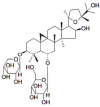Astragaloside IV Supplementation Promotes A Neuroprotective Effect in Experimental Models of Neurological Disorders: A Systematic Review
- PMID: 30207235
- PMCID: PMC6712289
- DOI: 10.2174/1570159X16666180911123341
Astragaloside IV Supplementation Promotes A Neuroprotective Effect in Experimental Models of Neurological Disorders: A Systematic Review
Abstract
Background: Neurological disorders constitute a growing worldwide concern due to the progressive aging of the population and the risky behavior they represent. Herbal medicines have scientific relevance in the treatment of these pathologies. One of these substances, Astragaloside IV (AS-IV), is the main active compound present in the root of Astragalus membranaceus (Fisch.) Bge, a Chinese medicinal herb with neuroprotective properties.
Objective: In the present study we performed a systematic review that sought to comprehend the neuroprotective effect presented by AS-IV in experimental models of neurological disorders.
Methods: This study is a systematic review, where an electronic search in United States National Library of Medicine (PubMed), Science Direct, Cochrane Library, Scientific Electronic Library Online (SciELO), Scopus, Web of Science, Medline via Proquest and Periodicos Capes databases covering the years between 2007 and 2017, using "Astragaloside IV" and "Neurodegenerative diseases"; "Astragaloside IV" and " Neurological disorders" as reference terms was made.
Results: A total of 16 articles were identified, in which the efficacy of AS-IV was described in experimental models of Parkinson's disease, Alzheimer's disease, cerebral ischemia and autoimmune encephalomyelitis, by improving motor deficits and/or neurochemical activity, especially antioxidant systems, reducing inflammation and oxidative stress.
Conclusion: The findings of the present study indicate that the administration of AS-IV can improve behavioral and neurochemical deficits largely due to its antioxidant, antiapoptotic and antiinflammatory properties, emerging as an alternative therapeutic approach for the treatment of neurological disorders.
Keywords: Alzheimer's disease; Neurological disorders; Parkinson's disease; astragaloside IV; brain; cerebral ischemia..
Copyright© Bentham Science Publishers; For any queries, please email at epub@benthamscience.net.
Figures



Similar articles
-
Astragaloside IV: A promising natural neuroprotective agent for neurological disorders.Biomed Pharmacother. 2023 Mar;159:114229. doi: 10.1016/j.biopha.2023.114229. Epub 2023 Jan 16. Biomed Pharmacother. 2023. PMID: 36652731 Review.
-
Neuroprotective effects of Astragaloside IV in 6-hydroxydopamine-treated primary nigral cell culture.Neurochem Int. 2009 Nov;55(6):414-22. doi: 10.1016/j.neuint.2009.04.012. Epub 2009 May 4. Neurochem Int. 2009. PMID: 19409437
-
[Neurobiological potential of astragaloside IV and prospects for its use in the treatment of Alzheimer's disease].Zh Nevrol Psikhiatr Im S S Korsakova. 2025;125(2):7-12. doi: 10.17116/jnevro20251250217. Zh Nevrol Psikhiatr Im S S Korsakova. 2025. PMID: 40047827 Review. Russian.
-
Astragaloside IV attenuates cognitive impairments induced by transient cerebral ischemia and reperfusion in mice via anti-inflammatory mechanisms.Neurosci Lett. 2017 Feb 3;639:114-119. doi: 10.1016/j.neulet.2016.12.046. Epub 2016 Dec 21. Neurosci Lett. 2017. PMID: 28011393
-
Effects of the Combination of the Main Active Components of Astragalus and Panax notoginseng on Inflammation and Apoptosis of Nerve Cell after Cerebral Ischemia-Reperfusion.Am J Chin Med. 2015;43(7):1419-38. doi: 10.1142/S0192415X15500809. Epub 2015 Oct 18. Am J Chin Med. 2015. PMID: 26477799
Cited by
-
Neuroprotective Effect for Cerebral Ischemia by Natural Products: A Review.Front Pharmacol. 2021 Apr 22;12:607412. doi: 10.3389/fphar.2021.607412. eCollection 2021. Front Pharmacol. 2021. PMID: 33967750 Free PMC article. Review.
-
Astragalus Mongholicus: A review of its anti-fibrosis properties.Front Pharmacol. 2022 Sep 7;13:976561. doi: 10.3389/fphar.2022.976561. eCollection 2022. Front Pharmacol. 2022. PMID: 36160396 Free PMC article. Review.
-
Anti-Aging of the Nervous System and Related Neurodegenerative Diseases With Chinese Herbal Medicine.Am J Alzheimers Dis Other Demen. 2023 Jan-Dec;38:15333175231205445. doi: 10.1177/15333175231205445. Am J Alzheimers Dis Other Demen. 2023. PMID: 37818604 Free PMC article. Review.
-
7,8-Dihydroxyflavone and Neuropsychiatric Disorders: A Translational Perspective from the Mechanism to Drug Development.Curr Neuropharmacol. 2022;20(8):1479-1497. doi: 10.2174/1570159X19666210915122820. Curr Neuropharmacol. 2022. PMID: 34525922 Free PMC article. Review.
-
Modulation of the vitamin D receptor by traditional Chinese medicines and bioactive compounds: potential therapeutic applications in VDR-dependent diseases.Front Pharmacol. 2024 Jan 22;15:1298181. doi: 10.3389/fphar.2024.1298181. eCollection 2024. Front Pharmacol. 2024. PMID: 38318147 Free PMC article. Review.
References
-
- Uttara B., Singh A.V., Zamboni P., Mahajan R.T. Oxidative stress and neurodegenerative diseases: a review of upstream and downstream antioxidant therapeutic options. Curr. Neuropharmacol. 2009;7(1):65–74. [http://dx.doi.org/10.2174/157015909787602823]. [PMID: 19721819]. - PMC - PubMed
-
- Freire M.A.M. Pathophysiology of neurodegeneration following traumatic brain injury. West Indian Med. J. 2012;61(7):751–755. [PMID: 23620976]. - PubMed
-
- Guimarães J.S., Freire M.A.M., Lima R.R., Souza-Rodrigues R.D., Costa A.M., dos Santos C.D., Picanço-Diniz C.W., Gomes-Leal W. Mechanisms of secondary degeneration in the central nervous system during acute neural disorders and white matter damage. Rev. Neurol. 2009;48(6):304–310. [PMID: 19291655]. - PubMed
-
- Batista P., Pereira A. Quality of life of patients with neurodegenerative diseases. J. Neurol. Neurosci. 2016;7:1–7. [http://dx.doi.org/10.21767/2171-6625.100074].
-
- Norrara B., Doerl J.G., Guzen F.P., Cavalcanti J.R.L.P., Freire M.A.M. Commentary: Localized vs. systematic neurodegeneration: A paradigm shift in understanding neurodegenerative diseases. Front. Syst. Neurosci. 2017;11:91. [http://dx.doi.org/10.3389/fnsys.2017.00091]. [PMID: 29270113]. - PMC - PubMed
Publication types
MeSH terms
Substances
LinkOut - more resources
Full Text Sources
Other Literature Sources
Medical
Research Materials

